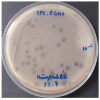Antibiotic Resistance Profile and Bio-Control of Multidrug-Resistant Escherichia coli Isolated from Raw Milk in Vietnam Using Bacteriophages
- PMID: 38921792
- PMCID: PMC11206458
- DOI: 10.3390/pathogens13060494
Antibiotic Resistance Profile and Bio-Control of Multidrug-Resistant Escherichia coli Isolated from Raw Milk in Vietnam Using Bacteriophages
Abstract
E. coli is an important zoonotic pathogen capable of causing foodborne illness and bovine mastitis. Bacteriophages have been increasingly considered a promising tool to control unwanted bacteria. The aim of this study is to determine the antibiotic resistance profile of E. coli isolated from raw milk and the efficacy of phage in controlling multidrug-resistant E. coli in raw milk. Antibiotic susceptibility testing showed the highest resistance rates of E. coli isolates to co-trime (27.34%) and ampicillin (27.34%), followed by streptomycin (25.18%), tetracycline (23.02%), and the lowest resistance rates to ciprofloxacin, gentamycin, and ceftazidime, all at a rate of 2.16%. All isolates were susceptible to meropenem. Of the 139 E. coli isolates, 57 (41.01%) were resistant to at least one antibiotic, and 35 (25.18%) were classified as MDR strains. Molecular characterization indicated that 5 (3.6%) out of the 139 isolates were STEC strains carrying stx1 gene. Seven (5.04%) isolates were phenotypically identified as ESBLEC, and four isolates (2.88%) were resistant to colistin. The results of the genotypic test revealed that four out of seven ESBLEC strains carried both blaTEM and blaCTX-M-1, two harbored blaTEM, and one possessed blaCTX-M-1, while mcr-1 was detected in all four colistin-resistant E. coli isolates. In particular, one isolated E. coli strain (EM148) was determined to be a multidrug-resistant strain simultaneously carrying blaTEM, blaCTX-M-1, and mcr-1. A total of eight phages were successfully recovered from raw milk. The application of phage PEM3 significantly reduced viable counts of multidrug-resistant host EM148 in raw milk by at least 2.31 log CFU/mL at both 24 °C and 4 °C.
Keywords: E. coli; antibiotic resistance; bacteriophages; multidrug resistance.
Conflict of interest statement
Author Gary A. Flory was employed by the company G.A. Flory Consulting. The remaining authors declare that the research was conducted in the absence of any commercial or financial relationships that could be construed as a potential conflict of interest.
Figures





Similar articles
-
Antimicrobial resistance profiles of Pseudomonas aeruginosa, Escherichia coli and Klebsiella pneumoniae strains isolated from broiler chickens.Food Microbiol. 2024 Jun;120:104476. doi: 10.1016/j.fm.2024.104476. Epub 2024 Jan 10. Food Microbiol. 2024. PMID: 38431322
-
Characterization and virulence factors distribution of blaCTX-M and mcr-1carrying Escherichia coli isolates from bovine mastitis.J Appl Microbiol. 2021 Aug;131(2):634-646. doi: 10.1111/jam.14994. Epub 2021 Jan 20. J Appl Microbiol. 2021. PMID: 33411963
-
Virulence Determinants and Plasmid-Mediated Colistin Resistance mcr Genes in Gram-Negative Bacteria Isolated From Bovine Milk.Front Cell Infect Microbiol. 2021 Nov 23;11:761417. doi: 10.3389/fcimb.2021.761417. eCollection 2021. Front Cell Infect Microbiol. 2021. PMID: 34888259 Free PMC article.
-
Molecular Detection and Antimicrobial Resistance Patterns of Shiga Toxigenic Escherichia coli Isolated from Bovine Subclinical Mastitis Milk Samples in Kurdistan, Iran.Arch Razi Inst. 2020 Jun;75(2):169-177. doi: 10.22092/ari.2019.124238.1278. Epub 2020 Jun 1. Arch Razi Inst. 2020. PMID: 32621445 Free PMC article.
-
Abundance of colistin-resistant Escherichia coli harbouring mcr-1 and extended-spectrum β-lactamase-producing E. coli co-harbouring blaCTX-M-55 or -65 with blaTEM isolates from chicken meat in Vietnam.Arch Microbiol. 2022 Jan 15;204(2):137. doi: 10.1007/s00203-021-02746-0. Arch Microbiol. 2022. PMID: 35032196
References
-
- Havelaar A.H., Kirk M.D., Torgerson P.R., Gibb H.J., Hald T., Lake R.J., Praet N., Bellinger D.C., De Silva N.R., Gargouri N. World Health Organization Global Estimates and Regional Comparisons of the Burden of Foodborne Disease in 2010. PLoS Med. 2015;12:e1001923. doi: 10.1371/journal.pmed.1001923. - DOI - PMC - PubMed
-
- Burow E., Rostalski A., Harlizius J., Gangl A., Simoneit C., Grobbel M., Kollas C., Tenhagen B.-A., Käsbohrer A. Antibiotic resistance in Escherichia coli from pigs from birth to slaughter and its association with antibiotic treatment. Prev. Vet. Med. 2019;165:52–62. doi: 10.1016/j.prevetmed.2019.02.008. - DOI - PubMed
Grants and funding
LinkOut - more resources
Full Text Sources


